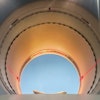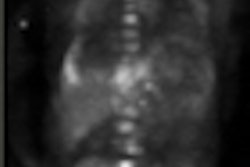Lymphedema is one of the most common and dreaded side effects experienced by breast cancer survivors. But the risk of radiation-induced damage to lymph nodes during radiation therapy may be reduced with the use of SPECT/CT during treatment planning, according to findings presented at this month's San Antonio Breast Cancer Symposium.
By identifying critical drainage lymph nodes with SPECT/CT, researchers at the Mayo Clinic in Rochester, MN, have been able to design radiation therapy programs that reduce by up to 55% the number of these nodes that receive damaging radiation doses. This reduces the incidence of lymphedema, a chronic swelling of tissue in the arm.
Radiation oncologists at Mayo are conducting an ongoing prospective study of women diagnosed with low-risk, localized, early-stage breast cancer who undergo breast conservation surgery followed by radiation therapy. Patients enrolled in the study either have confirmed negative lymph node involvement or micrometastases to the sentinel lymph node.
The women, immobilized in the treatment position, have both a CT scan for radiation therapy treatment planning and a SPECT/CT scan. A radiopharmaceutical based on filtered technetium-99m sulfur colloid enables SPECT/CT to identify the precise locations of the small, nonpathological lymph nodes that drain the arm after breast cancer surgery. The SPECT/CT images are registered with the planning CT, and draining lymph nodes are contoured automatically using a threshold of 50% maximum intensity.
For the study, two treatment plans are generated for each patient: One is a conventional radiation therapy treatment plan, whereas the second has treatment fields modified to minimize dose to the lymph nodes visible on the SPECT/CT images, while ensuring that a radiation dose of 50 Gy or its biologic equivalent is delivered to the tumor bed.
"When comparing the lymph node radiation between the plans, we identified dramatic reductions in radiation to critical lymph nodes in the SPECT/CT-adapted plans," said Andrea Cheville, MD, a specialist in lymphedema management and a consultant in Mayo Clinic's department of physical medicine and rehabilitation.
"By locating critical drainage lymph nodes and contouring the treatment plan to avoid delivering radiation dose to as many as possible, we are minimizing potential damage to them," Cheville explained. "While a woman can have as many as 62 lymph nodes under the armpit, there are only a few responsible for drainage."
Cheville reported that in a cohort of 25 women, 52 draining lymph nodes were identified. Using a conventional treatment plan, 68% would have received a maximum radiation dose of more than 10 Gy and 38% a dose of more than 40 Gy. With the modified plan created by knowing the precise location of the draining lymph nodes, only 38% received a radiation dose of more than 10 Gy and 10% a dose of more than 40 Gy.
To date, no cases of lymphedema have been reported, but this is expected because radiation-induced lymph node morbidities typically do not occur for two to five years following radiation therapy.
The technique of locating critical lymph nodes and blocking them from radiation may prove most useful for patients who require surgical removal of lymph nodes in the armpit, but who do not require radiation targeting for any remaining nodes, according to Cheville. She explained that these patients' risk of developing lymphedema may be as high as 50% without radiation exposure blocking.
"If we are able to minimize damage to the lymphatic system during breast cancer treatment, this may have a critical effect on these patients' long-term quality of life," Cheville said. "Sentinel node biopsy has been radically effective in reducing discomfort caused when multiple lymph nodes are removed, and hopefully this modified radiation therapy treatment will be as beneficial."
The next step to test the effectiveness of the individually tailored radiation therapy is to conduct a randomized clinical trial of women who have undergone axillary lymph node dissection of all level 1 and 2 nodes from the armpit, Cheville suggested.
"A randomized clinical trial will more accurately estimate the benefit that we hypothesize can be achieved," she said.
By Cynthia E. Keen
AuntMinnie.com staff writer
December 13, 2010
Related Reading
Axillary reverse mapping limits lymphedema after breast cancer surgery, October 7, 2010
Obesity raises risk of cancer-related lymphedema, December 23, 2008
Skin thickness measurement helps diagnose breast lymphedema, December 15, 2008
Axillary dissection ups risk of lymphedema with sentinel lymph node biopsy, October 23, 2008
SPECT/CT improves sentinel node detection in overweight breast cancer patients, February 14, 2007
Copyright © 2010 AuntMinnie.com




















